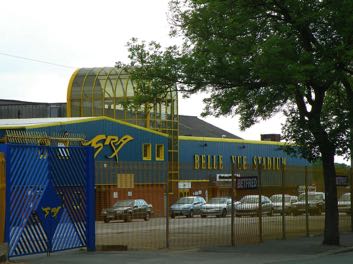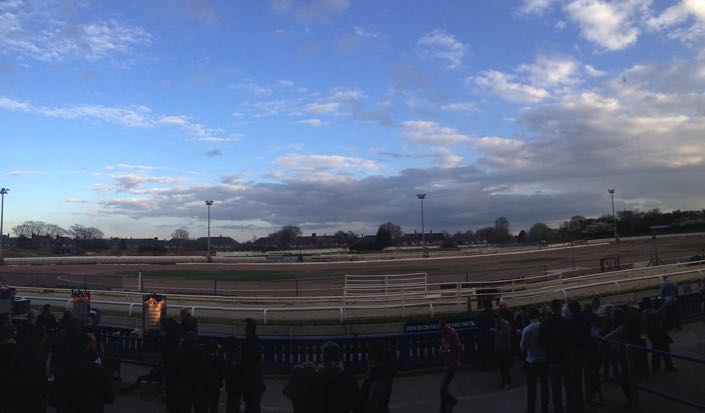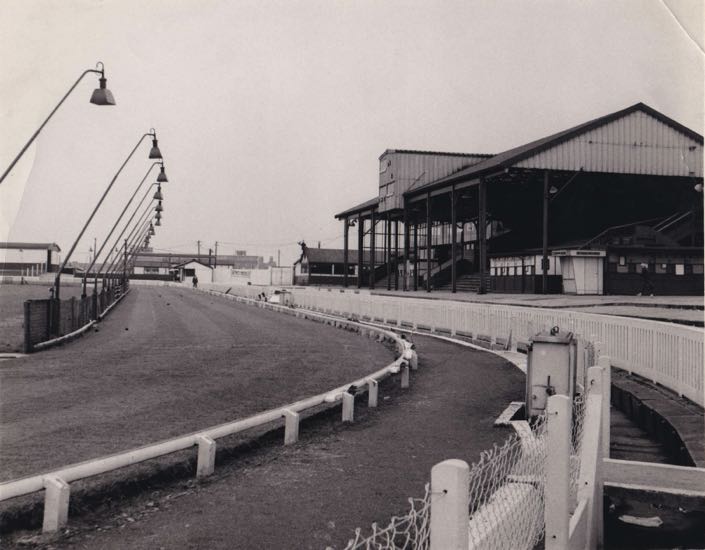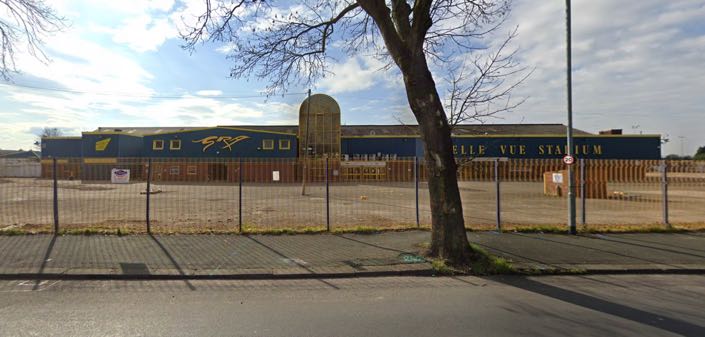- Address: Kirkmanshulme Ln, Gorton, Manchester M18 7BA
- Status: Permanently Closed

Belle Vue was one of the most famous greyhound racing tracks in the United Kingdom, thanks in no small part to the fact that it was where the first race around an oval track took place in the country. That was on the 24th August, 1926, being owned and operated for the majority of its time by the Greyhound Racing Association. It was bought by the Crown Oil Pension Fund in 2014, with racing taking place during three evenings, as well as some afternoons thanks to its position as part of the Bookmakers Afternoon Greyhound Service.
As well as greyhound racing, the track also played home to speedway racing, with the Belle Vue Aces operating there from 1988 until 2015. Some of the biggest races in the sport were hosted at Belle Vue, including the Cesarewitch, the Gold Collar and the Oaks. The closure of Belle Vue came in 2020, accelerated by the global health crisis at the time. It re-opened when it was legally allowed to do so, but the opening only lasted for one meeting before it closed again, never to re-open. Demolition began in May of 2021.
Major Races & Events

Unsurprisingly, given Belle Vue’s status in the sport, the stadium hosted some of the biggest races in the sport of greyhound racing. Whilst some of these were specific to the north of England, such as the Northern Flat, the Northern Stayers Stakes and the Manchester Cup, others were big events that were moved to other venues when Belle Vue shut. Here are the main events, alongside the race track that they now take place at:
- The Laurels – Perry Barr Stadium
- The Cesarewitch – Crayford Stadium
- The Oaks – Perry Barr Stadium
- Scurry Gold Cup – Perry Barr Stadium
- Northern Flat – Newcastle Stadium
- Gold Collar – Crayford Stadium
As you can see, Perry Barr Stadium, on the outskirts of Birmingham, was the major beneficiary in terms of races being moved after the closure of Belle Vue. The Laurels, the Oaks and the Scurry Gold Cup are all considered to be Classics in the sport of greyhound racing, so it was something of a coup for Perry Barr to be able to take all three of them on, just as it had been for Belle Vue to race them in the first place.
In the News
It is not a shock to learn that most of the news about Belle Vue that has happened in the time since its closure has been about what happened next. In May of 2021, for example, the news broke that demolition work had begun in preparation for the building of 160 houses and 80 apartments on the site. A few months later and a group called We Shut Down Belle Vue wrote about how they had succeeded in their campaign to get the greyhound racing venue shut down, though how much it was to do with them and how much it was about corporate greed isn’t clear.
About Belle Vue Greyhound Stadium

There is arguably more to say about Belle Vue Stadium than any of the other greyhound racing venues that opened around the country in the years after its success. Its story began in 1925, which was the year that an American businessman named Charles A. Munn signed a deal to promote greyhound racing in Great Britain. There had been an attempt to introduce mechanical racing at Hendon years earlier that had failed, but Munn had confidence in his ability to get the sport off the ground on account of the continued popularity of coursing.
Munn got in touch with one of field sports’ leading figures, Major L. Lyne Dixson, showing him a presentation of how greyhound racing could work in the United Kingdom. They initially struggled to bring others on board, however, before Brigadier-General Alfred Critchley decided that they were onto something. He introduced them to Sir William Gentle, a Justice of the Peace, and between them they managed to raise £22,000, forming the Greyhound Racing Association Limited. Now they just needed somewhere to host the racing, with Manchester considered the perfect city.
The Opening of Belle Vue
The combination of sporting links in the city of Manchester with the evident love of gambling by its citizens meant that it was thought to be the best place for the new stadium to be opened. They found some land close to the city centre and began work building a purpose-built venue for greyhound racing, naming it Belle Vue after the nearby Zoological Gardens. An oval track was created, the first of its kind in Great Britain for greyhounds, and more 1,700 people turned up to see the opening meeting on the 24th of July, 1926.
Six races of seven dogs per race were held during that first meeting. The first race was won by a dog called Mistley, who would later have a stand named after it, coming home out of trap one at odds of 6/1. Major-General T Anderson was installed as the Director of Racing, whilst L. V. Browne became the Racing Manager. Initially, there were fears from the Greyhound Racing Association that they had made a terrible mistake, which was based on the fact that they had actually made a loss of £50. When 16,000 people turned up for the next meeting, however, such panic was averted.
Racing Develops
Over the first three months of the new sport’s existence in Manchester, 37 meetings were held and 221 races took place. The consortium that formed the GRA was able to repay a bank loan of £10,000 that it had taken out, whilst the shares of the new company rose from one shilling to more than £37. That is the equivalent of a five pence initial investment becoming £37.50. Heading out to watch greyhound racing became a national pastime, with the Greyhound Racing Association growing to become a hugely influential company.
By the middle of 1927, nearly 70,000 people were heading to Belle Vue every week. When the National Greyhound Racing Club was formed the following year, it introduced a limit on the number of dogs that could run in a race to six, but even that didn’t limit Belle Vue’s success. What was being achieved in Manchester led to other stadiums being built up and down the country, with people desperate to replicate what was happening. Unsurprisingly, the best trainers and owners wanted to work with Belle Vue, leading to success following.
Bonzo won the Grand National, which was known as the Champion Hurdle at the time, in 1927, with Dresden winning the English Greyhound Derby three years later. The Northern Flat was introduced, whilst about 320 heated kennels on-site ensured that the dogs were amongst the best-treated in the country. Even the outbreak of the Second World War couldn’t stop racing’s popularity, with racing instead being limited to either daytimes or summer evenings. Charles A. Munn had created a monster, with he and his associates reaping the benefits.
The Post-War Years
Ballypatrick won the Scottish Greyhound Derby in 1957, which was one of the first major events to be won by a dog trained out of Belle Vue. The Racing Manager and Trainer positions at the stadium were chopped and changed over the years, but the success was consistent throughout. In 1961, an under-track heating system was introduced at the stadium, with Harringay and White City also getting the technology. It was a useful invention in the years before all-sand tracks, helping to avoid cold weather cancellations.
Stan Mitchell was named Greyhound Trainer of the Year in 1970, then one of greyhound racing’s Classics, the Cesarewitch, was moved to Belle Vue when West Ham closed. This was also the decade in which Belle Vue was given a facelift to the tune of half a million pounds, including a state-of-the-art restaurant and Tote facilities. Races such as the Laurels and the Gold Collar moved to and from the stadium during the 1990s and 2000s, including the GRA’s decision to send the Oaks to Towcester in 2018.
Records at Belle Vue
As you might imagine, there were some genuinely competitive races run at Belle Vue over the years. As a result, there were some impressive records set over the various distances that were run, a select few of which were as follows:
| Distance | Record Time | Date Set |
|---|---|---|
| 237 Metres | 14.02 Seconds | 31st July 2005 |
| 250 Metres | 14.20 Seconds | 18th May 1990 |
| 260 Metres | 14.78 Seconds | 14th October 2017 |
| 470 Metres | 27.20 Seconds | 4th October 2007 |
| 470 Metres | 27.20 Seconds | 31st August 2019 |
| 590 Metres | 35.03 Seconds | 19th September 2015 |
| 670 Metres | 40.15 Seconds | 20th August 2009 |
| 878 Metres | 54.28 Seconds | 8th November 2011 |
| 465 Metre Hurdles | 27.34 Seconds* | 10th May 2005 |
| 465 Metre Hurdles | 27.34 Seconds | 7th August 2005 |
| 470 Metre Hurdles | 27.85 Seconds | 9th June 2009 |
* This record was set during the final of the Gold Collar
The Closing of the Track: What Happened to Belle Vue Greyhound Stadium?

In 2014, the National Asset Management Agency, which was the parent company of the Greyhound Racing Association at the time, made the decision to sell Belle Vue to the Crown Oil Pension Fund for £2.6 million. As part of the agreement, a leaseback to the GRA Acquisition was agreed until 2028, costing £249,000 per year. Mutual break options were put into the 15-year tenancy agreement, which was similar to the leaseback deal that had been agreed at Hall Green Stadium. That was triggered in July of 2017, with Hall Green closing as a result.
In October of 2019, the lease was sold by GRA Acquisition to Arena Racing Company. On the 19th of December, planning permission was passed for housing to be built on the site. On the first of August 2020, an announcement about the imminent closure was made. The outbreak of a global health crisis accelerated the closure of Belle Vue, which did re-open but only managed to do so for one final race meeting before closing permanently. ARC released a statement saying that there was ‘no longer a business case to support the ongoing operation of the stadium’.